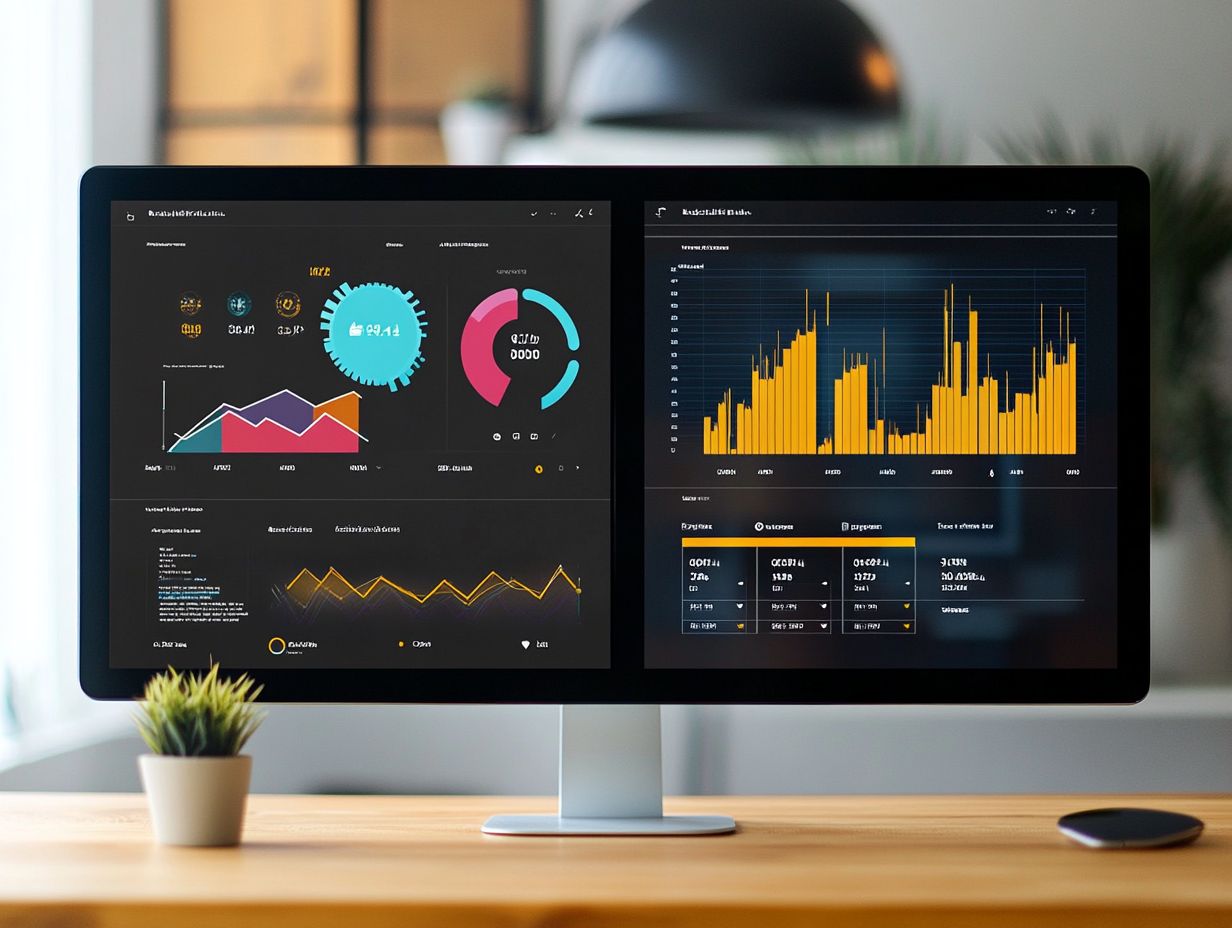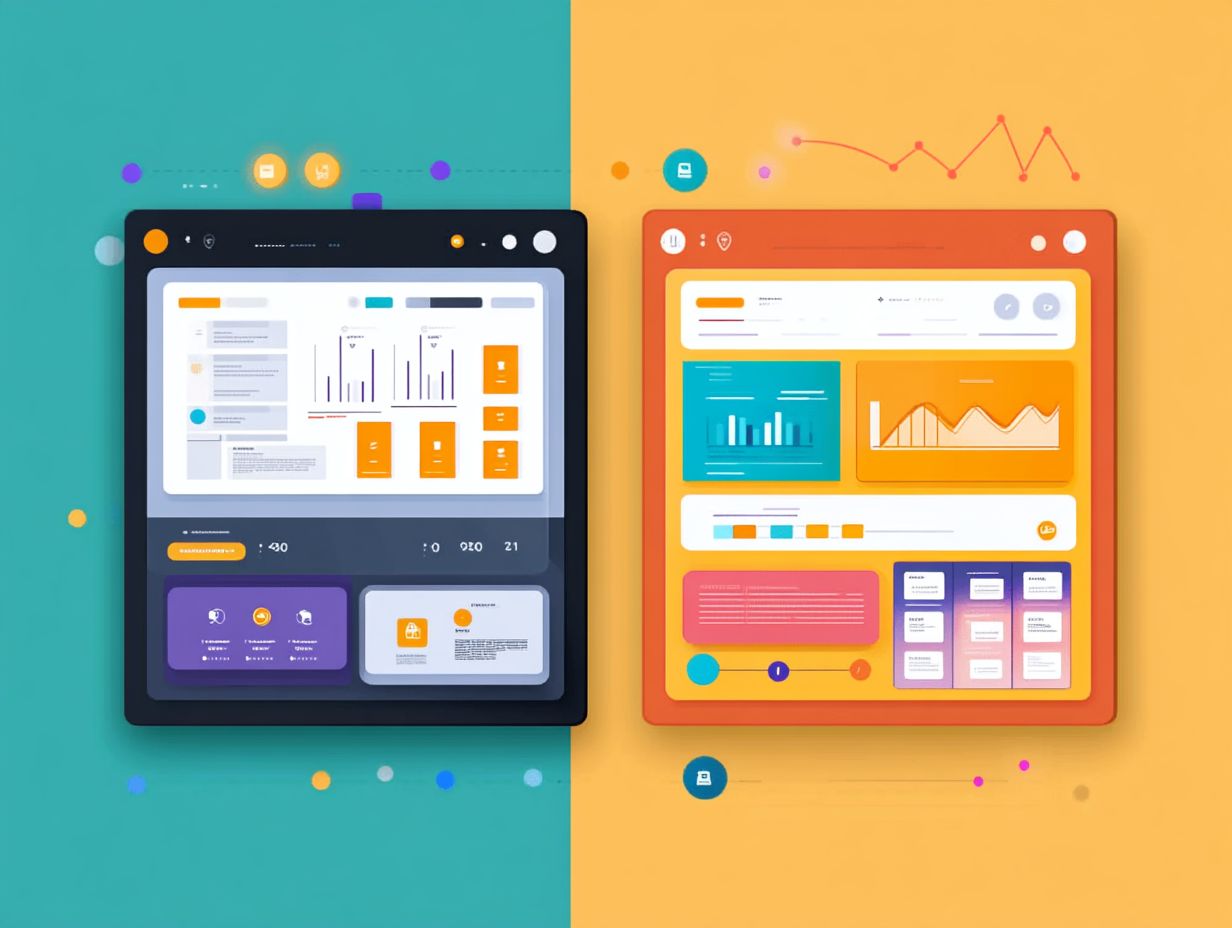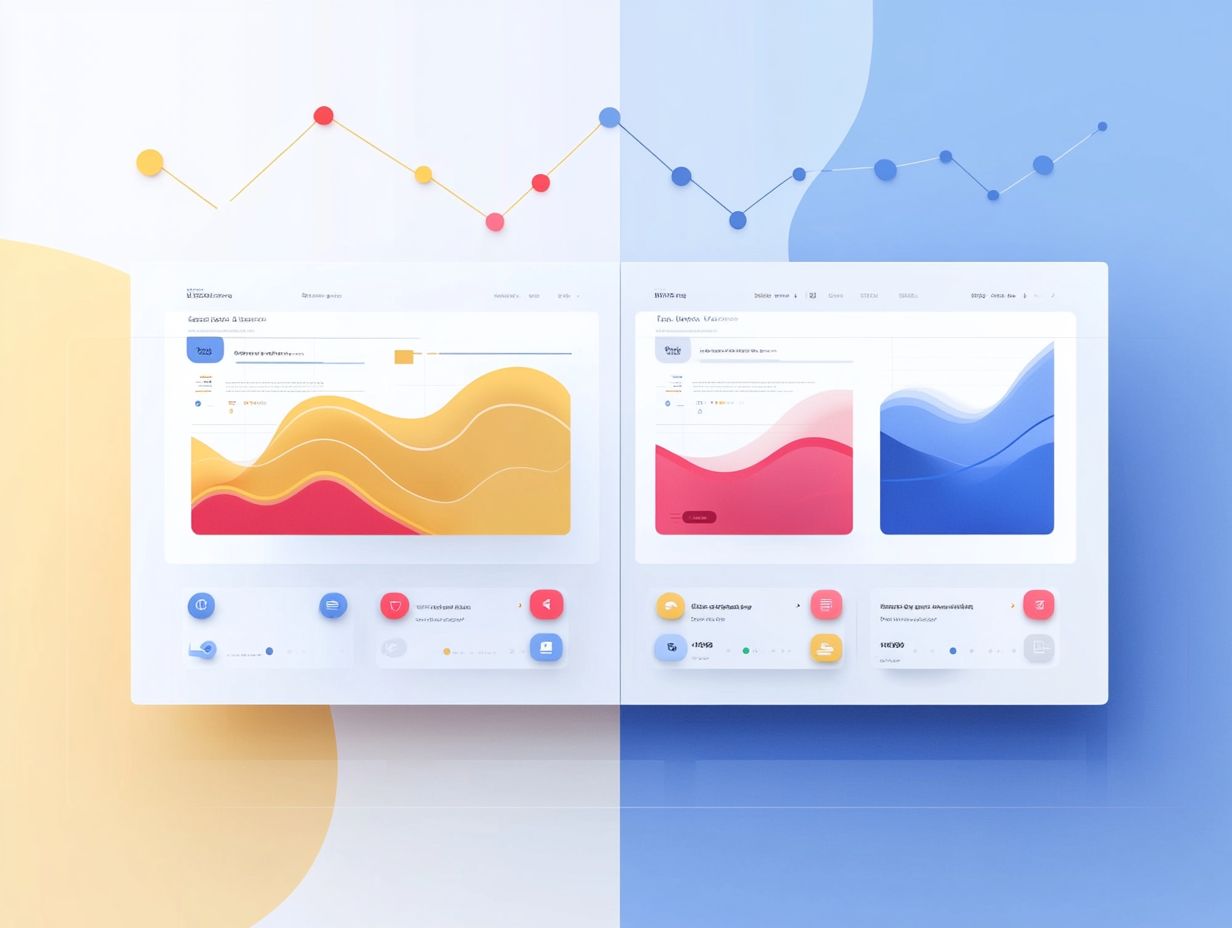A/B Testing: Best Practices for Affiliates
A/B testing is an invaluable tool that can elevate your affiliate marketing efforts, enabling you to make informed, data-driven decisions.
This article delves into the world of A/B testing, highlighting its advantages in enhancing conversion rates and boosting revenue. It provides insights into best practices for selecting the right elements to test, setting up effective experiments, and interpreting the results with precision.
You ll also uncover common pitfalls to avoid and gain access to valuable tools and resources that will sharpen your testing skills. Whether you re just starting with A/B testing or aiming to fine-tune your strategy, this guide offers valuable insights tailored for everyone.
Contents
- Key Takeaways:
- Benefits of A/B Testing for Affiliates
- Best Practices for A/B Testing
- Common Mistakes to Avoid in A/B Testing
- Tools and Resources for A/B Testing
- Frequently Asked Questions
- What is A/B testing and why is it important for affiliates?
- What are some best practices for conducting A/B testing as an affiliate?
- Can A/B testing be used for different types of affiliate marketing strategies?
- How can I measure the success of my A/B testing as an affiliate?
- Are there any common mistakes to avoid when conducting A/B testing as an affiliate?
- Is A/B Testing a Continuous Effort for Affiliates?
Key Takeaways:

- A/B testing can greatly benefit affiliates by improving conversion rates and revenue.
- Choose the right things to test for the best results, set up and conduct tests, and interpret results to make changes.
- Common mistakes to avoid in A/B testing include overlooking key metrics, not testing for a sufficient amount of time, and ignoring user feedback.
What is A/B Testing?
A/B testing, often referred to as split testing, is a powerful method for comparing two versions of a web page, email, or other marketing assets to see which one performs better in achieving your specific marketing goals.
By leveraging version A against version B, you can analyze key metrics such as conversion rates, click-through rates, and overall user experience. This allows you to make data-driven decisions that enhance website performance and refine your marketing campaigns.
This systematic approach helps refine your content and shapes your future marketing strategies. For example, in email marketing, A/B testing can show which subject lines get more opens. On your website, it can optimize layouts and calls to action for improved engagement. Major platforms like Google and HubSpot provide robust A/B testing tools that empower you to execute these tests with ease.
Understanding important results is vital for interpreting your findings; it ensures that any observed differences truly reflect user preferences. This insight can profoundly influence your marketing analytics and guide you toward immediate success.
Benefits of A/B Testing for Affiliates
The advantages of A/B testing for affiliates are substantial, offering improved conversion rates, heightened user engagement, and optimized marketing strategies that ultimately drive increased revenue and lead generation opportunities. To achieve this, it’s beneficial to follow the best practices for promoting affiliate programs.
By meticulously analyzing audience behavior through thorough A/B testing, you gain insights into what resonates with your target market. This guarantees your marketing hits the mark every time!
Improving Conversion Rates and Revenue
Improving your conversion rates and revenue through A/B testing is essential to maximize the effectiveness of your marketing campaigns. By systematically testing different elements like call-to-action buttons, email subject lines, and landing pages you can gain invaluable insights into your audience’s preferences and behavior. This ultimately leads to a more successful customer journey and increased sales.
Understanding how various segments of your audience respond will deepen your insights, enabling you to tailor your strategies more effectively. For example, a leading e-commerce company that implemented A/B testing on its product recommendations experienced a remarkable 20% increase in sales simply by adjusting the layout based on user interaction data.
Such metrics are not just numbers; they inform your current decisions and shape your future marketing strategies. Tracking these performances goes beyond mere testing; it evolves into crafting personalized experiences that foster greater customer loyalty and enhance lifetime value.
Best Practices for A/B Testing
Implementing best practices for A/B testing is crucial for obtaining results that truly matter. To enhance your strategy, consider resources on how to test my affiliate marketing tactics, ensuring that the insights you gather are both valid and actionable.
By thoughtfully selecting the elements you want to test, determining an appropriate sample size, and utilizing the right marketing tools, you can conduct A/B testing that effectively enhances user experience and drives successful sales improvement.
Choosing the Right Elements to Test

Choosing the right elements to test in A/B testing is essential for uncovering valuable insights that fuel your sales improvement efforts. You should concentrate on key components like call-to-action buttons, product images, and email subject lines to see which variations generate the best results in user interaction and engagement.
By honing in on these elements, you ll gain a clearer understanding of how even minor adjustments can significantly influence user behavior and overall performance. For example, tweaking the color or placement of a call-to-action button could lead to impressive increases in click-through rates, while testing different product images might uncover preferences that resonate more deeply with your target audience.
To prioritize which aspects to analyze, consider past user interactions, conversion rates, and customer feedback. This strategic approach ensures that your resources are directed toward elements with the highest potential return on investment, ultimately enhancing the user experience and boosting your conversion rates.
Setting Up and Conducting Tests
Setting up and conducting A/B tests demands careful planning and execution to yield valid results and actionable insights. You’ll need to determine the test duration, select the right audience for your tests, and establish clear objectives for the marketing experiments you’re undertaking.
Before diving into any experiment, it’s crucial to define what success looks like; this clarity will guide your analysis later on. The recommended test duration typically spans at least one business cycle, allowing enough data to accumulate for reliable conclusions.
Choosing a representative audience is key to ensuring that your findings are applicable to your broader customer base, minimizing biases along the way. Various tools, such as Google Optimize or Optimizely, can streamline the setup and provide robust analytics to help you interpret the outcomes. This makes the entire process smoother and more efficient.
Interpreting Results and Making Changes
Unlock incredible insights from your A/B testing results! By giving you the power to make informed decisions, rooted in data collection and analysis, you can implement strategic changes to your campaigns that enhance sales improvement and elevate overall performance.
This process requires you to delve into specific metrics such as click-through rates, bounce rates, and time spent on pages, providing a comprehensive understanding of user behavior. Utilizing marketing analytics tools allows you to uncover not just surface-level data but also deeper insights, including user demographics and engagement patterns.
For example, if your A/B test reveals that a particular call-to-action button drives higher engagement, it s wise to adopt similar strategies across your digital platforms. Making data-driven decisions such as tweaking design elements or adjusting messaging based on these insights can lead to significant improvements and ultimately boost your return on investment.
Common Mistakes to Avoid in A/B Testing
Avoiding common mistakes in A/B testing is essential for maintaining the integrity of your tests and the validity of your results. Many marketers tend to overlook key metrics, fail to run tests for an adequate duration, or disregard valuable user feedback.
These oversights can significantly compromise the effectiveness of your A/B testing efforts. Don t miss out on potential sales! Start A/B testing today to see immediate improvements in your results.
Overlooking Key Metrics
Overlooking key metrics in A/B testing can steer you toward misguided conclusions and ineffective marketing strategies. Metrics such as the percentage of clicks and conversion rates are crucial for evaluating the success of different versions, empowering you to make informed, data-driven decisions.
In the whirlwind of digital marketing, grasping these metrics is essential for fine-tuning your campaigns and enhancing overall performance. By tracking engagement metrics alongside conversion rates, you can pinpoint what captures attention and what ultimately drives sales.
This comprehensive perspective highlights the necessity of selecting the right version in a test while ensuring performance is quantitatively assessed. Neglecting these critical indicators can seriously hold back your growth, leading to wasted resources and missed opportunities.
By adopting a metric-centered approach, you can elevate your strategies and pave the way for sustainable success.
Not Testing for a Sufficient Amount of Time

Not allowing for a sufficient testing period can skew your A/B testing results, leading to inaccurate conclusions. You must ensure a large enough sample size and ample time to reach statistical significance before making decisions based on your findings.
Failing to allow enough time for tests often means you’ll miss crucial patterns in audience behavior. Rushing through tests risks drawing conclusions from random anomalies instead of genuine trends, which can undermine your strategies.
To determine the right testing periods, consider factors such as your marketing goals, anticipated user engagement levels, and the seasonal behavior of your audience. By aligning your test duration with these factors, you enhance the reliability of your results and lead to more effective marketing campaigns.
Ignoring User Feedback
Ignoring user feedback during the A/B testing process can lead you to miss valuable opportunities for refining your marketing strategies. Actively seeking and integrating user insights helps you align your efforts with the preferences of your audience.
This alignment deepens your understanding of what resonates with your target audience and enables informed decision-making. For example, qualitative feedback from email recipients can unveil preferences that mere numbers might miss.
Collecting feedback through surveys after an A/B test can spotlight areas for improvement. When you prioritize these insights, you significantly enhance the effectiveness of your marketing campaigns, driving better engagement and increasing conversion rates.
Tools and Resources for A/B Testing
Harnessing the right tools for A/B testing can elevate your marketing efforts, delivering invaluable insights. By utilizing statistical significance calculators, which indicate whether results are likely due to chance, you can simplify the A/B testing process, empowering yourself to make more informed decisions.
Popular A/B Testing Software
Popular A/B testing software like OptinMonster and Google Optimize offers you an array of powerful features, designed to streamline your testing processes and enhance campaign performance.
These tools come equipped with user-friendly interfaces, strong analysis tools, and seamless integration with various marketing platforms.
By enabling you and your team to easily set up experiments and analyze results, these A/B testing solutions empower you to make informed, data-driven decisions. For example, OptinMonster shines in generating high-converting lead pages.
Meanwhile, Google Optimize pairs flawlessly with Google Analytics for comprehensive tracking and insights. You can effectively compare performance metrics such as conversion rates and user engagement, allowing you to refine your strategies with precision.
Both tools offer targeting options that let you reach specific audience segments, ensuring tailored experiences that can significantly boost your ROI. These functionalities elevate your marketing efforts and deepen your understanding of user behavior, ultimately leading to improved customer satisfaction.
Additional Resources for Learning and Improving A/B Testing Skills
Dive into exciting resources to boost your A/B testing skills! Free templates, online courses, and insightful blogs dedicated to marketing strategies offer invaluable insights that can refine your A/B testing practices.
If you re keen to deepen your understanding, consider looking into books like “A/B Testing: The Most Powerful Way to Turn Clicks Into Customers”, which provides practical guidance and real-world case studies.
Online platforms such as Coursera and Udemy present comprehensive courses crafted by industry experts, allowing you to learn at your own pace. Engaging with community forums like the Testing Community on Reddit or specialized Facebook groups fosters dynamic discussions and idea-sharing among practitioners.
This creates an opportunity for you to gather real-world advice and solutions. By utilizing these diverse resources, you not only build a solid foundation of knowledge but also adopt a hands-on approach to mastering A/B testing.
Frequently Asked Questions

What is A/B testing and why is it important for affiliates?
A/B testing, also known as split testing, is a method of comparing two versions of a webpage or marketing campaign to determine which one performs better. It is crucial for affiliates because it allows them to optimize their strategies and improve conversion rates. Adopting best practices for ethical affiliate marketing can ultimately lead to increased revenue.
What are some best practices for conducting A/B testing as an affiliate?
Some best practices for A/B testing as an affiliate include setting clear goals and metrics, testing one variable at a time, using a large enough sample size, and running tests long enough to gather reliable data. For more detailed strategies, refer to our comprehensive guide on split testing.
Can A/B testing be used for different types of affiliate marketing strategies?
Absolutely! A/B testing can be applied to various types of affiliate marketing strategies, such as email marketing, landing pages, ad copy, and social media posts. Understanding the best practices for affiliate link placement is a versatile tool that can enhance almost any aspect of affiliate marketing.
How can I measure the success of my A/B testing as an affiliate?
The success of A/B testing can be measured by comparing key metrics such as click-through rates, conversion rates, and revenue for the different versions being tested. It is important to track these metrics before and after the test to accurately determine the impact of the changes made.
Are there any common mistakes to avoid when conducting A/B testing as an affiliate?
Yes, some common mistakes to avoid include making changes based on personal opinions rather than data, not testing for a sufficient duration, and using an inadequate sample size. It is also important to only test one variable at a time to accurately measure its impact.
Is A/B Testing a Continuous Effort for Affiliates?
A/B testing is a continuous effort for affiliates, and there’s always room for improvement and new testing opportunities.
Continuously monitor and optimize your strategies. This approach helps you stay ahead of the competition and maximize your revenue.






